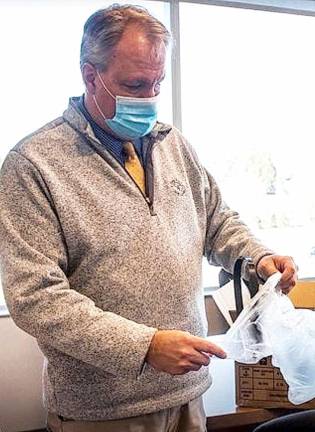Orange County District Attorney’s office copes with COVID and state criminal justice reforms
Goshen. The office now has a backlog of 5,000 cases just ‘sitting there and growing all the time’ because of the impact of COVID-19.


The Orange County District Attorney’s Office has significantly changed its way of doing business in an effort to cope with a pandemic that arrived just as it was adjusting to path-breaking state criminal justice reforms.
“My staff weathered these storms extremely well, working every day, in person or remotely to keep the Office in operation,” Orange County District Attorney David Hoovler said in a statement accompanying his recently released annual report for 2020. “As a result, we were able to keep moving forward in our duty to protect the public from crime. We look forward, optimistically, to 2021.”
This year’s report “looks different,” Hoovler writes in the document. It is missing many of the statistics that sprinkled previous versions coming as it does amid a virulent disease that has slowed down every facet of the criminal justice system.
The impact of COVID
With the disease surging, arrests plunged for several months. In-person court operations were suspended in March except for emergencies, then resumed, only to be recently “paused” again.
Hoovler said in an interview that his office handled only 11,000 cases in 2020, far below the 20,000 or so of previous years. Constitutional requirements make it difficult to negotiate and accept pleas and sentence offenders virtually, and the office has been unable to dispose of many cases that have reached it.
It now has a backlog of 5,000 cases just “sitting there and growing all the time,” Hoovler said.
The DA issued personal protective equipment, including masks, face-shields, gloves and hand sanitizer to all prosecutors and investigators. More than a dozen personnel tested positive during the year. Each incident was disruptive, requiring multiple assistant district attorneys and staff members to quarantine after being exposed to a positive individual at home or in the office.
Assistant district attorneys were instructed to interview witnesses and police on the telephone wherever possible. The county spent $700,000 for laptop computers and cellphones for all prosecutors and investigators and other technology upgrades.
Prosecutors now have the capacity to access case files work from their residences as if they were in the office, the report says.
The effect of the state’s ‘so-called’ reforms
Meanwhile, several what the report characterizes as “so-called” reforms went into effect on Jan. 1, 2020. The new mandates eliminated bail for many defendants; required prosecutors to turn over a great deal more evidence more quickly to defense counsel; and forced the office to assign assistant district attorneys to local courts for night and weekend arraignments to match the defense attorneys who are mandated by the Constitution to attend.
The office has been under a hiring freeze, and the staff is working “harder than ever,” said Hoolver, who is advocating a raise for them.
The office must operate required to operate 15-16 hours a day, seven days a week, compared to its old 9-to-5, M-F schedule.
‘Early case assessment bureau’
To cope with the heavier workload, it has reorganized from several specialized bureaus to a three general units for greater flexibility. But the most radical change has been the establishment of an “early case assessment bureau,” similar to the “complaint bureau” Manhattan has had for decades.
The new system took over from the county’s 36 police agencies the task of writing the “accusatory instruments” that start criminal proceedings. According to the report, prosecutors talk to police over the phone and input any information into the DA’S computerized case management system.
Previously, prosecutors might not learn about a matter until they attended one of the often intermittent sessions in one of the county’s 72 local courts – too late for the state’s deadlines.
Under the previous system, only 3 to 5 percent of cases were litigated, requiring all materials to be turned over to defense, usually at the end of the case.
Now 100 percent of discovery must be turned over within 20 days of the beginning of the case for incarcerated defendants and 35 days for non-incarcerated defendants.
That has put a “tremendous strain” on police and prosecutors, Hoovler said.
“The (early assessment) system allows for lawyers instead of police officers to draft the legal documents that commence a case, while at the same time ensuring that defendants obtain the materials they are entitled to, and that prosecutors can identify sensitive victim and witness information that may need to be protected by applications to the court,” the report says.
’A major change’
The modification in arrest procedures was “a major change” Mount Hope Police Paul Rickard, president of the Police Chiefs’ Association of Orange County, said in an interview and there were some “growing pains” in the beginning, resistance from police agencies that Hoovler characterized as “blowback.”
However, Rickard said that Hoovler had been “very open-minded” in dealing with complaints, which “really helped us to overcome the issues out there.” As they became more familiar with the state changes, the chiefs concluded that the bureau was necessary, he added.